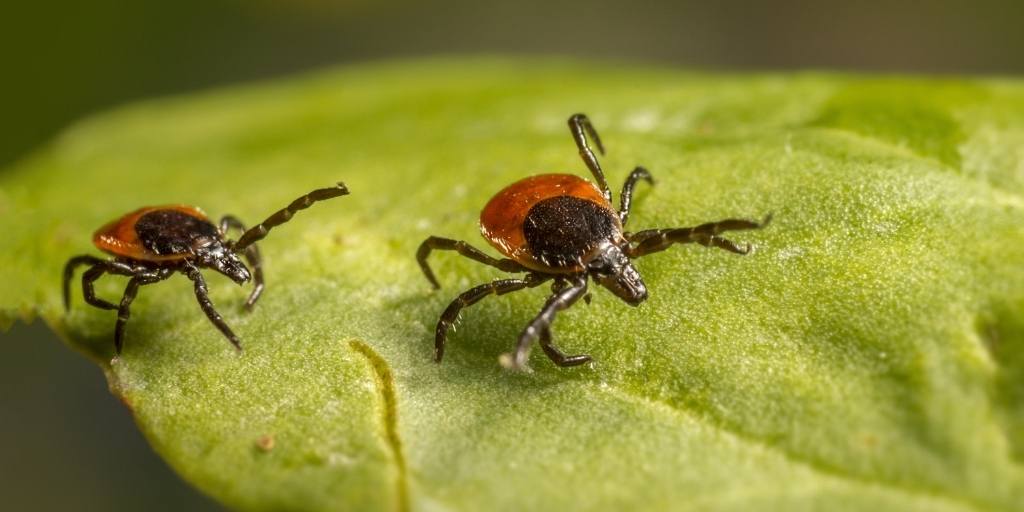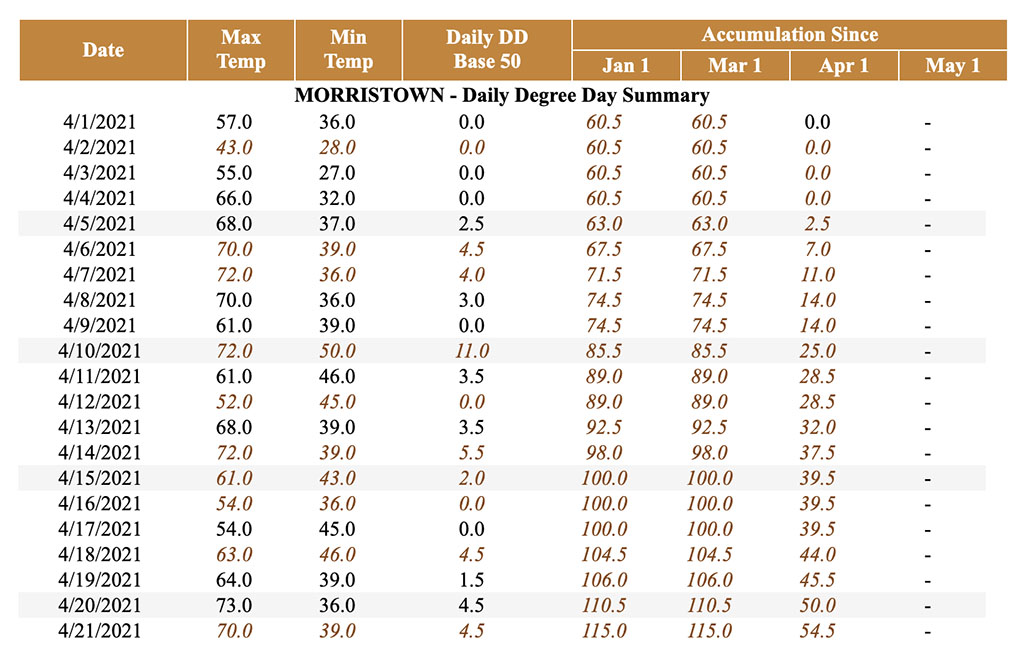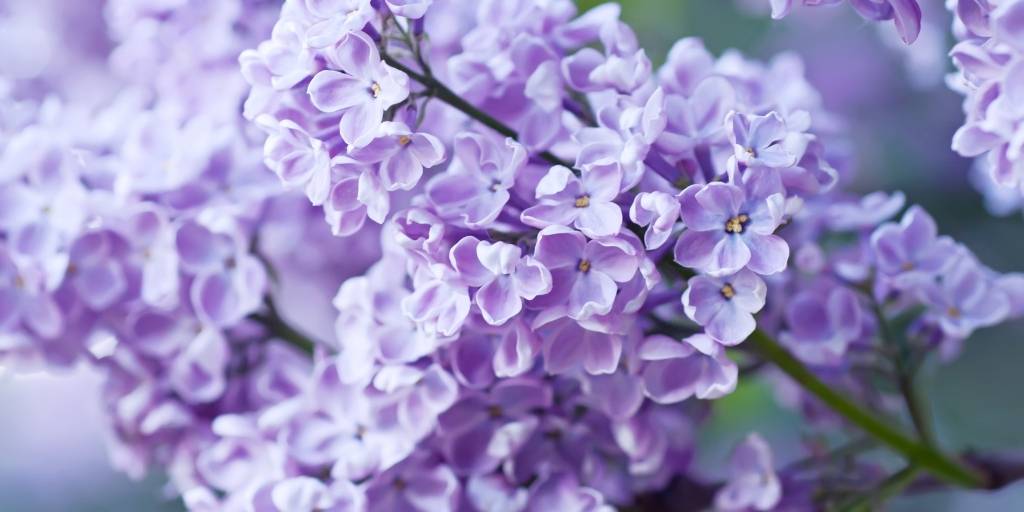When is the right time to apply insecticide to control emerald ash borer? What’s the best time for fungicide treatments to prevent anthracnose? When should I expect to see spotted lanternflies on my trees? And what about tick treatments?
Such simple questions but, unfortunately, there isn’t a simple answer!
You’ve probably noticed that plant growth, along with bugs and plant diseases, appears earlier some years but much later other years.
Unlike holidays and birthdays, the emergence of fungal and bacterial diseases or insect populations isn’t determined by a date on your calendar. Instead, timing is based on the weather.
There’s a general timeframe during which we typically start to notice plants growing and insects moving about. However, but timeframe can vary dramatically from year to year.
For example, a cold, wet spring slows down the growth and development of plants and insects. In contrast, warmer temperatures speed things up so leaves and plant problems appear earlier.
As a result, the timing for pest and disease prevention and control treatments will also vary from year to year.

Without timely treatment, pests like ticks are more difficult (or even impossible) to control
Why Proper Treatment Timing is Critical
A professional tree or plant health management company will tell you the average timeframe during which specific treatments are generally applied. You can see our typical treatment timing here. However, they won’t set a specific date for treatments until closer to the application date.
As a customer, we know how frustrating that can be. But there’s a good reason for it!
If you apply treatment products too early, the pest or pathogen you’re trying to address probably hasn’t yet appeared.
If you apply it too late, you’ll miss the window of opportunity during which the treatment will be effective.
Either way, it’s a waste of time and money, as the treatment won’t have the desired effect.
Instead, professionals keep a close watch on weather conditions to know when to apply treatments at the time when they’ll be most effective.
Knowing When to Apply Treatments
So how do you know exactly when to apply treatments for maximum effectiveness?
It’s not a simple matter. The most important determinant is the number of Growing Degree Days (GDD). But weather, such as rain or snow, also plays a role. And when it comes to tree growth and flowering, the fertility and nutrient content of the soil also affects timing.
Growing Degree Days
Growing Degree Days is a calculation based on the number of days (since January 1 of the current year) during which the average temperature was higher than the minimum temperature needed for a plant, pest, or disease organism to develop.
Each plant, destructive insect, and disease pathogen has a minimum temperature below which it cannot grow. That temperature is called the base temperature or lower developmental threshold. Once the average daily temperature goes above the threshold for that organism, it starts to grow.
For most GDD calculations, 50F is used as the base temperature because most woody plants and insects start to grow or develop at that point. Each day we look at the average temperature (the maximum temperature plus the minimum temperature, divided by 2) and subtract 50 to get the GDD for that day.
If the average temperature is below 50F then we have 0 GDD. If the average temperature is 70F, we would have 20 GDD (i.e., 70 – 50).
Or, to make things easier, just use this handy GDD tracking tool put out by the Network for Environment and Weather Applications at Cornell University. It will show the accumulated number of Growing Degree Days for your location.
For example, using Cornell’s NEWA site, we can see that as of April 21, 2021, we’ve accumulated 115 GDD since January 1 of this year.

Growing Degree Days for 2021 in Morristown, NJ through April 21.
An Example
We know that Eastern tent caterpillar (Malacosoma Americanum) can be successfully treated between 90 and 190 GDD.
To show you how this affects the timing of Eastern tent caterpillar treatment, we looked at the GDD here in Morristown, NJ on April 21 each year for the last five years. On that day, GDD ranged from a low of 49 in 2018 to a high of 143 in 2017.
This means that on April 21 in 2018 it would be too early to apply treatments, whereas in 2017 it would be getting to the end of the treatment window.

When lilacs are in full bloom, pine needle scale eggs usually start to hatch
Another Way to Know When to Apply Treatments
But what if you don’t have access to a Growing Degree Days calculator? Luckily, there’s another general guideline we can use to estimate the right time to spray fungicides, apply insecticides, or otherwise treat tree pests and diseases. It’s called plant phenological indicators.
We know that plant development is temperature-dependent – trees, flowers, and weeds don’t leaf out or bloom until certain temperatures are reached. In other words, GDDs also influence plant development. That means we can use the development of specific plants to predict pest development.
For example, we know that just after Star Magnolia and Forsythia first bloom (at about 83-86 GGD), Eastern Tent Caterpillar eggs will begin to hatch (around 90 GDDs). When common lilacs are in full bloom, eggs of the pine needle scale will start to hatch. And when black locust trees bloom, adult bronze birch borers emerge.
So we can use the flowering sequence of plants as a sort of “biological calendar” to predict pest activity. For homeowners, it’s an easy way to know when to apply pest management treatments.
Each pest and pathogen has a range of GDD during which treatment is effective. Outside that range, there’s little point in applying biological or chemical controls.

Wet, cool spring conditions encourage sap-sucking pests, like aphids, that feed on juicy new leaves
How Spring Weather Affects Pest, Disease & Plant Problems
Wet, cool spring conditions encourage sap-sucking pests, like aphids, that feed on juicy new leaves. We also see the rapid development of fungi, such as powdery mildew, cedar apple rust, and anthracnose.
In contrast, warm, dry spring weather reduces the likelihood of fungal problems and aphids. However, it increases populations of pests that thrive in those conditions, such as spider mites.
The difference in precipitation levels can also have a significant impact on insect activity, such as feeding, mating, and travel, as well as the development and vigor of host plants.
For example, after a wet spring, leaf-eating pests enjoy feeding on the lush, green vegetation. But trees and landscape plants are better able to ward them off (for example, by producing a plentiful supply of resin).
In contrast, a late snowfall, ice storm, or hard freeze can kill or slow down the development of pests and fungi that have already reached (or would soon reach) the GDD baseline.
The Bottom Line
Plan your landscape and tree health treatments based on the weather, not on the calendar. Ticks, fungi, and insects can’t read calendars!
We always keep a close watch on the weather and GDDs. That means we can apply treatments at exactly the right time to ensure they’ll be optimally effective. While we know you’d like us to give you a precise timeframe for your tree and landscape treatments, we hope you now understand why that’s just not possible – and why it’s to your benefit that we don’t.




